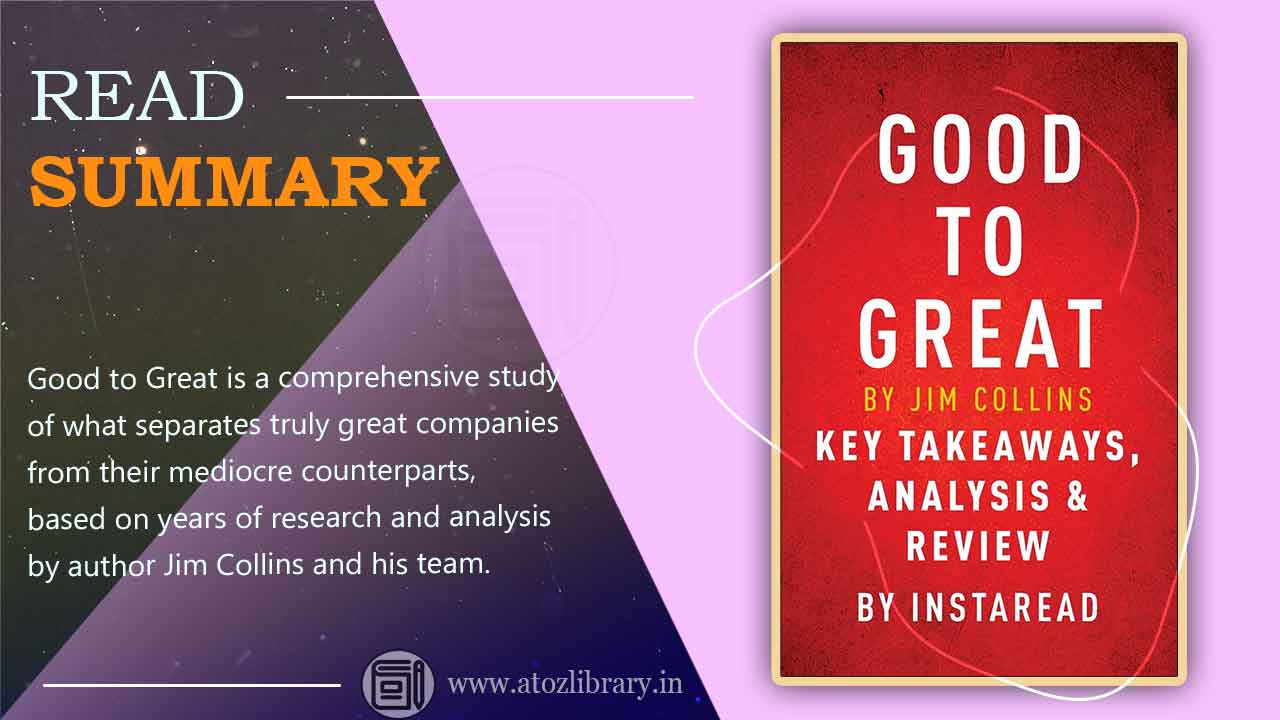Introduction
Good to Great: Why Some Companies Make the Leap… and Others Don’t is a seminal work written by Jim Collins, a management consultant and author. The book is based on a five-year research project that aimed to identify the key factors that distinguish great companies from just good ones. Collins and his team of researchers analysed data from 1,435 companies, including good and great ones, to determine the key principles that can help organizations make the transition from good to great.
In this article, we will summarize the key findings and insights from Good to Great and discuss why these principles are relevant to organizations of all sizes and industries today. Whether you’re a business owner, CEO, or simply someone who is interested in understanding the principles of organizational success, this book offers valuable insights and practical tips that can help you and your organization achieve greatness.
About The Author
Jim Collins is the author of Good to Great: Why Some Companies Make the Leap… and Others Don’t. He is a renowned management consultant and author, who has written several influential books on the topic of business and leadership. Collins is best known for his work in the field of organizational analysis, where he has developed and applied a number of innovative techniques to help companies understand and improve their performance.
His books are characterized by their rigorous research methods and practical insights, and they have been widely read and acclaimed by business leaders and executives around the world. In addition to Good to Great, Collins is also the author of several other best-selling books, including Built to Last and How the Mighty Fall.
Related post:- The Effective Executive Summary
Good Is the Enemy of Great
The “Good Is the Enemy of Great” chapter focused on the idea that many organizations get stuck in mediocrity because they are content with being “good enough.” Collins argues that being good is not the same as being great, and that the companies that make the leap from good to great are those that are willing to challenge themselves and push beyond their current level of performance.
In this chapter, Collins introduces the concept of the “Stockdale Paradox,” named after Jim Stockdale, a prisoner of war in Vietnam. The Stockdale Paradox states that, in order to achieve long-term success, you must maintain unwavering faith that you will eventually prevail in the end, while at the same time acknowledging the brutal reality of the situation. Collins applies this concept to organizations, arguing that great companies have the confidence to pursue their goals despite the challenges they face, while still being realistic about the obstacles in their way.
The chapter also addresses the idea that many companies get stuck in a pattern of complacency and incremental improvement. Collins argues that this is because they are afraid of taking the necessary risks to achieve greatness. He suggests that organizations need to embrace the “flywheel effect,” where small, incremental improvements over time can build momentum and eventually lead to great success.
Level 5 Leadership
The “Level 5 Leadership” chapter focused on the concept of leadership and the role it plays in helping organizations make the transition from good to great. Collins and his team of researchers discovered that the most successful companies in their study were led by a unique type of leader, which they referred to as “Level 5 Leaders.”
Level 5 Leaders are characterized by a combination of personal humility and professional will. They are ambitious for their companies, but they also have a strong sense of personal humility and are more focused on the success of the organization than on their own personal success. Level 5 Leaders also have a long-term perspective and are willing to make tough decisions to ensure the success of their organizations.
In this chapter, Collins also introduces the idea of “First Who, Then What.” He argues that organizations should focus first on building a strong leadership team, and then on implementing their strategies and plans. Collins suggests that having the right people in leadership positions is essential to achieving great results, and that organizations should not be afraid to make changes to their leadership teams if necessary.
Here Author highlights the importance of building a culture of accountability and responsibility within organizations. Level 5 Leaders are able to create a culture where everyone is held accountable for their actions and where everyone takes responsibility for the success of the organization.
Related post:- Start with why summary by Simon Sinek: Powerful Book For Purposeful Leadership
First Who . . . Then What
This chapter focuses on the importance of building the right team in order to achieve great results. Collins and his team of researchers discovered that the most successful companies in their study started with the right people on their teams before they even began to implement their plans and strategies.
In this chapter, Collins introduces the idea that “who” you have on your team is more important than “what” you do. He argues that organizations should focus on getting the right people on their teams before they begin to implement their plans and strategies. This means that organizations should focus on building a team of highly talented and motivated individuals who are aligned with the organization’s goals and values.
Author highlights the importance of building a culture of accountability and responsibility within organizations. Collins argues that organizations should focus on creating a culture where everyone is held accountable for their actions and where everyone takes responsibility for the success of the organization.
Confront the Brutal Facts
The Chapter focuses on the importance of facing reality and making tough decisions in order to achieve great results. Collins and his team of researchers discovered that the most successful companies in their study were able to make the transition from good to great by facing the brutal facts about their current situations and making tough decisions to change their direction.
In this chapter, Collins introduces the idea that organizations should face the brutal facts about their current situations, no matter how difficult or unpleasant they may be. He argues that organizations should be honest about their strengths and weaknesses, and that they should be willing to make tough decisions in order to change their direction if necessary.
It also highlights the importance of never losing faith in the organization’s ability to achieve great results. Collins argues that organizations should have a strong sense of belief in their ability to achieve great results, even in the face of difficult and challenging circumstances.
The Hedgehog Concept
“The Hedgehog Concept (Simplicity within the Three Circles)” chapter focuses on the importance of finding a simple and focused approach to achieve great results. Collins and his team of researchers discovered that the most successful companies in their study were able to make the transition from good to great by finding a simple and focused approach to their business.
In this chapter, Collins introduces the idea of the “Hedgehog Concept,” which is a framework for finding a simple and focused approach to business. The Hedgehog Concept involves three circles: what you are deeply passionate about, what you can be the best in the world at, and what drives your economic engine. The intersection of these three circles represents the sweet spot of what the organization should focus on in order to achieve great results.
The Chapter also highlights the importance of simplicity and focus in order to achieve great results. Collins argues that organizations should simplify their approach and focus on what they do best in order to achieve great results.
Related post:- Naked Economics by charles wheelan: The fundamental principles of economics
A Culture of Discipline
The “A Culture of Discipline” Discuses on the importance of discipline and consistent behavior in achieving great results. Collins and his team of researchers discovered that the most successful companies in their study were characterized by a culture of discipline, which allowed them to achieve great results.
In this chapter, Collins introduces the idea of a culture of discipline, which involves a commitment to consistent behavior and a focus on achieving long-term goals. He argues that organizations should establish a culture of discipline in order to achieve great results, and that this culture should be embodied by the leaders of the organization.
chapter “A Culture of Discipline” also highlights the importance of a focus on the long-term in order to achieve great results. Collins argues that organizations should have a long-term focus, and that they should be willing to make tough decisions and trade off short-term gains for long-term success.
Technology Accelerators
Technology Accelerators chapter of Good to Great Discuses on the role of technology in achieving great results. Collins and his team of researchers discovered that technology played a significant role in the success of the companies in their study, but that it was not the primary driver of their success.
In this chapter, Collins argues that technology can be an accelerator of great results, but that it should not be relied upon as the primary driver of success. He argues that organizations should view technology as a tool to support their efforts, rather than as the solution to their problems.
Technology Accelerators chapter also highlights the importance of using technology in a disciplined manner, and the dangers of over-investing in technology. Collins argues that organizations should use technology in a way that supports their overall strategy, and that they should be careful not to over-invest in technology at the expense of other areas of the business.
The Flywheel and the Doom Loop
The Flywheel and the Doom Loop chapter focuses on the importance of building momentum in achieving great results. Collins and his team of researchers discovered that the most successful companies in their study were able to build momentum through a series of small, consistent actions, rather than through one big push.
In this chapter, Collins introduces the concept of the “flywheel,” which he describes as a large, heavy wheel that takes a lot of effort to get started, but once it is moving, it builds momentum and becomes easier to turn. He argues that organizations should view their efforts to achieve great results as a flywheel, and focus on building momentum through a series of small, consistent actions.
This Chapter also introduces the concept of the “doom loop,” which is the opposite of the flywheel. The doom loop involves trying to achieve great results through one big push, rather than through a series of small, consistent actions. Collins argues that organizations should avoid the doom loop and instead focus on building momentum through the flywheel.
From Good to Great to Built to Last
From Good to Great to Built to Last compares and contrasts the findings of Collins’ study of companies that made the leap from good to great with his previous study of companies that were built to last.
In this chapter, Collins argues that the companies that made the leap from good to great and the companies that were built to last had different characteristics and faced different challenges. He argues that while the companies that made the leap from good to great faced the challenge of making a transformation, the companies that were built to last faced the challenge of preserving their greatness over time.
It also highlights the importance of having a clear understanding of the difference between the two types of companies, and the importance of recognizing that both types of companies have their own unique challenges and strengths. Collins argues that organizations should focus on developing their own strengths and addressing their own challenges, rather than trying to emulate other companies.
Related post:- Book Yourself Solid summary: Unlock Your Potential with Clients In Details
Conclusion
Good to Great: Why Some Companies Make the Leap… and Others Don’t is a book that explores the reasons why some companies are able to make the transition from being good to becoming great, while others are not. Through extensive research and analysis, the author, Jim Collins, identifies the key factors that contribute to this transformation. These factors include having a Level 5 leader, focusing on the right people and the right goals, confronting brutal facts, having a clear understanding of the organization’s purpose, and maintaining a culture of discipline.
In conclusion, Good to Great provides valuable insights into the characteristics and practices that are common among companies that have made the leap from good to great. The book is a must-read for anyone interested in understanding the factors that contribute to organizational success and how organizations can make the transition from being good to becoming great.





